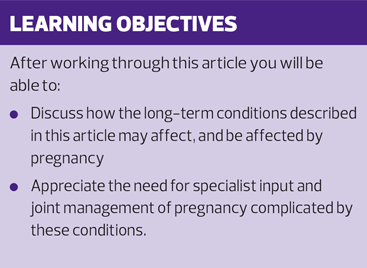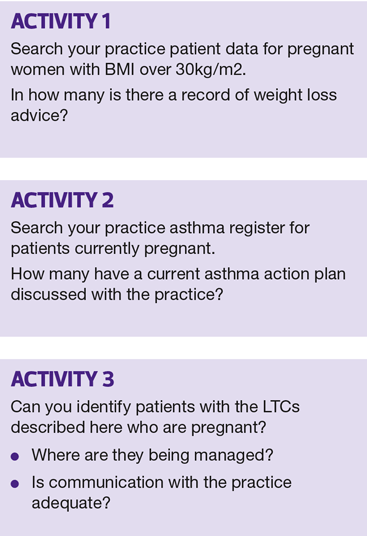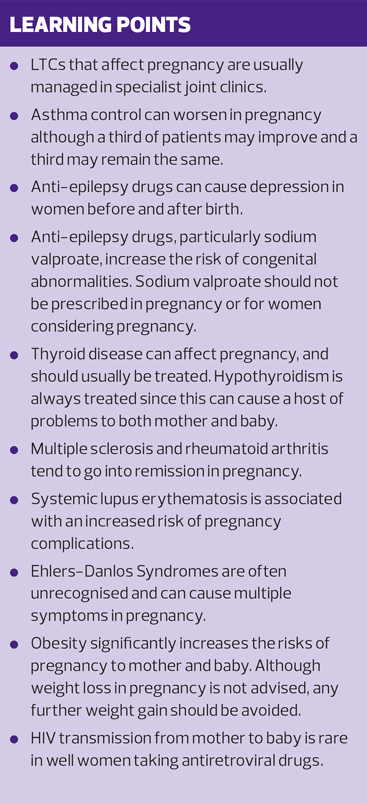Optimising management of long term conditions in pregnancy - Part 2
Dr Mary Lowth
Dr Mary Lowth
MA MB BChir FRCGP PGCMedEd
The second article in our series discusses the impact on pregnancy and management of asthma, thyroid disease and epilepsy – including the latest cautions on sodium valproate – obesity and other long term conditions
Some pregnant patients with the long-term conditions (LTCs) covered in this article – asthma, epilepsy, thyroid disease, autoimmune disease, obesity, Ehlers-Danlos syndrome, HIV and genital herpes – will attend specialist clinics, but others will have their LTC managed by the practice. It is important, as always, to be professionally self-aware and to realise the limits of your expertise. Even if you manage hundreds of patients with these conditions, if you have rarely managed them in pregnancy you should seek other professional input.
ASTHMA1
Although asthma can occasionally appear for the first time in pregnancy, for most pregnant women with asthma, the asthma came first.
How does pregnancy affect asthma?
You might expect pregnancy to have a beneficial effect on asthma, given that it is a steroid-rich condition. In fact, asthma in pregnant women is unpredictable:
- One third see their asthma worsen, usually in the second and third trimesters, peaking between 24 and 36 weeks.
- About one third find their asthma unchanged.
- About one third see their asthma improve in pregnancy.
Women with more severe pre-pregnancy asthma are more likely to get worse, as are women whose asthma got worse in a previous pregnancy.
How does asthma affect pregnancy?
Asthma is most likely to affect pregnancy if it is severe or poorly controlled, when it affects the placental oxygen supply. Uncontrolled asthma increases the risk of hyperemesis and miscarriage early on, and of high blood pressure and preeclampsia later. The baby is at increased risk of poorer growth and prematurity.
How is asthma managed in pregnancy?
Women with asthma should be made aware that their asthma may worsen in pregnancy, and that while breathlessness is common in pregnancy, it may signify worsening asthma.
All pregnant women with asthma should have a personal asthma action plan, reviewed regularly. Those with severe or worsening asthma, and those who have an acute asthma attack in pregnancy need specialist clinic involvement.
Lung function should be monitored using peak flow or spirometry, and fetal movements monitored from 28 weeks. If there are concerns about the baby’s well-being, more intensive monitoring is needed. Smoking should be strongly discouraged, and women with asthma should have seasonal flu vaccine (as is recommended for all pregnant women.)
All asthma inhalers are safe in pregnancy. Oral montelukast is not usually started during pregnancy, but can be continued in women already taking it.
Women on oral prednisolone (over 7.5mg per day) are given intravenous steroids during labour to avoid withdrawal, although asthma attacks in labour are unusual as the body’s steroid levels are then high. Breastfeeding may reduce the chances of the baby developing asthma.
EPILEPSY2
Epilepsy affects 0.5-1% of women: about a third of women with epilepsy (WWE) are of reproductive age. Women who have been seizure-free, off medication, for ten years are considered to no longer have epilepsy. Seizures in late pregnancy in women not known to be epileptic are more likely to have other causes, such as eclampsia, cerebrovascular abnormalities, cardiac arrhythmias, faints with hypoxia and hypoglycaemia.
Anti-epileptic drugs increase the chance of congenital abnormalities in the baby, particularly neural tube defects, but stopping drugs suddenly increases the seizure risk. Women are advised to seek advice before they plan a baby, so that drugs can be changed. Low-dose lamotrigine, carbamazepine and levetiracetam have the lowest risk. Higher-dose folic acid is protective. WWE who become unexpectedly pregnant should NOT stop or change drugs until they have seen a specialist.
How does epilepsy affect pregnancy?
Anti-epileptic drugs (AEDs) cause increased rates of low mood and depression, poor concentration and tiredness, both in pregnancy and the post-partum period. There is a slightly increased risk of miscarriage, hypertension, preeclampsia, prematurity, antepartum haemorrhage and slow growth in the baby.
Epilepsy also increases the (very low) risk of maternal death through SUDEP (sudden unexpected death in epilepsy). This is most common in those with poorly controlled tonic-clonic seizures.
How does pregnancy affect epilepsy?
For most WWE, pregnancy does not worsen seizures. Two-thirds do not have a seizure in pregnancy and this figure rises to 90% in those seizure-free in the year prior to pregnancy.
The remaining women may suffer increased seizures. About 1 in 100 will have a seizure during labour, but most have a delivery unaffected by their epilepsy. The babies of those taking AEDs are given vitamin K at birth.
How are women with epilepsy managed in pregnancy?
WWE should be under the care of a specialist neurologist and epilepsy nurse during pregnancy. Levels of AEDs in the blood may fall, and doses may need to be monitored and sometimes altered. The practice nurse has an important role in reviewing well-being in primary care, particularly given the increased risks of pre- and post-partum mood disorders.
Sodium valproate and pregnancy
Sodium valproate should be completely avoided in pregnancy. Exposure in utero carries a 10% risk of congenital malformations including neural tube defects, craniofacial abnormalities, hypospadias and heart defects, and a dose dependent risk of up to 30-40% of neurodevelopmental disorders, including developmental delay, intellectual impairment and autism.
Reports of the greater risks of valproate, compared to other AEDs are relatively recent. In 2010 valproate was described as having a greater incidence of neural tube defects than other AEDs.3 The paper suggested that there might also be cognitive effects on children, but there wasn’t yet enough evidence to state this. Research intensified, and it became clear how great a risk valproate represents to the unborn baby. In 2015 the MHRA published strong advice regarding its use in women of childbearing age, and in 2016 these warnings were strengthened (Box 1).
Despite this, around 375 women become pregnant each year whilst taking valproate. There is an urgent need to identify women of childbearing age taking the drug, to review their care. A woman who is stable and fit-free on valproate is likely to be concerned at the consequences of a change in medication, and will need the support of secondary care to do so.
THYROID DISEASE4
The thyroid gland has a central role in pregnancy, and thyroid disease can both affect and be affected by pregnancy. Pregnancy particularly affects levels of thyroid hormone binding globulin, which can make thyroid function tests more difficult to interpret.
Hyperthyroidism occurs in 1 in 500 pregnancies. It is usually caused by Grave’s Disease, an autoimmune condition in which antibodies directly stimulate the thyroid into overproduction of thyroid hormone. Hyperthyroidism in early pregnancy can (rarely) occur transiently secondary to hyperemesis gravidarum.
Hypothyroidism occurs in about 5 in 1,000 pregnancies, usually caused by Hashimoto’s disease, also an autoimmune condition. In this case antibodies interfere with the thyroid’s ability to produce thyroid hormone. Both Grave’s disease and Hashimoto’s disease can be worsened by iodine supplements.
Postpartum thyroiditis affects around 5% of all women in the year after delivery, and consists of thyroid gland inflammation that causes a period of hyperthyroidism, sometimes followed by lasting hypothyroidism.
How does pregnancy affect thyroid disease?
Pregnancy places great demands on the thyroid gland, and can occasionally provoke new thyroid disease. However, women with pre-existing Graves’ disease usually see improvement, particularly in late pregnancy, often with a flare-up in the first few months after delivery.
In Grave’s disease antibodies cross the placenta to reach the baby’s thyroid, but if the mother is on anti-thyroid treatment then the treatment will reach the baby too. Women who have had Grave’s disease in the past but are not on treatment may still have antibodies. This can make the baby hyperthyroid, causing tachycardia, poor weight gain and irritability, and sometimes thyroid gland enlargement. Rarely, women with Grave’s disease can experience a dangerous episode of thyroid over-activity called a thyroid storm.
Uncontrolled hyperthyroidism increases the risks of pre-eclampsia, prematurity and low birth weight in the baby.
Uncontrolled hypothyroidism can cause a host of problems including miscarriage, still birth, infertility, maternal anaemia, pre-eclampsia, placental abruption, postpartum haemorrhage, premature delivery, and poor foetal growth. Untreated hypothyroidism can also cause neuro-developmental delay in the baby.
How is thyroid disease treated in pregnancy?
Pregnant women with known thyroid disease are usually seen in a joint thyroid/obstetric clinic. Mild hyperthyroidism in pregnancy doesn’t usually need treatment. More severe hyperthyroidism is treated with anti-thyroid drugs (keeping the dose as low as possible, to avoid making the baby hypothyroid). Sometimes treatment can be stopped in the last few weeks of pregnancy, although it may need to be started again afterwards. Higher doses of anti-thyroid drugs may mean women being advised not to breastfeed.
Hypothyroidism in pregnancy is always treated.
AUTOIMMUNE DISEASE5
Autoimmune conditions are caused by the development of antibodies to some of the body’s own, healthy cells. There are many autoimmune diseases, affecting – for example – joint linings (rheumatoid arthritis,[RA]), nerve sheaths (multiple sclerosis, [MS]), and connective tissues (systemic lupus erythematosus, [SLE]). Most women with autoimmune disease have specialist input prior to, and throughout, their pregnancy.
How does pregnancy affect autoimmune disease?
Some autoimmune conditions, notably MS and RA, tend to go into remission during pregnancy, although a post-partum flare is common. Other autoimmune diseases, including SLE, do not improve during pregnancy, and can be unpredictable, particularly in the first and second trimester. Many medications are contraindicated.
How does autoimmune disease affect pregnancy?
This varies with the condition. SLE, which is relatively common in women of childbearing age, increases the risk of preeclampsia, intrauterine growth retardation, prematurity, miscarriage and intrauterine death. Pregnant women with SLE should be looked after by a multidisciplinary team specialising in both conditions.
MS and RA do not significantly increase the risks to mother and baby in pregnancy although severe tiredness is common. In MS, any pre-existing physical disability may make pregnancy more difficult. Women with RA affecting the hips are more likely to need a Caesarean section.
EHLERS-DANLOS SYNDROMES6
The Ehlers Danlos Syndromes (EDS) are a group of disorders that affect connective tissue in skin and joints, making skin stretchy and slow to heal, and joints hypermobile. People with EDS often experience fatigue, headaches, nausea, low mood, dizziness, tinnitus and muscle and joint pains. Prolapse and hernia are more likely, and in some rare types of EDS there are more serious problems with blood vessels and internal organs. Hypermobility EDS is the most common form by far, and is thought to be greatly underdiagnosed.
How does pregnancy affect EDS?
Pregnancy tends to worsen EDS symptoms. Women with EDS are more likely to experience hyperemesis gravidarum, tiredness, low mood, low blood pressure, tinnitus and dizziness in early pregnancy, and musculoskeletal pain and pubic symphsysis pain in later pregnancy.
How does EDS affect pregnancy?
Cervical insufficiency, premature rupture of membranes and preterm birth, breech presentation, bleeding and poor wound healing (episiotomy or section), are all more common, although in mild hypermobility EDS the increased risks to the baby are small. Women with EDS often do not respond well to the usual epidural drugs, and need an alternative. Babies can have floppier muscle tone, and congenital hip dislocation is more common.
OBESITY7
Maternal obesity is an increasingly common problem. We need to be prepared to overcome our fear of offending patients and to discuss it openly with women – both those planning pregnancy and those who are already pregnant.
How does obesity affect pregnancy?
Women who are obese are more likely to experience miscarriage, prematurity and stillbirth, thromboembolic disorders, gestational diabetes and pre-eclampsia. They are more likely to have large babies, to experience shoulder dystocia and to need a Caesarean section or forceps delivery. Postpartum haemorrhage is more common. Epidurals can be technically more difficult to site. For the baby the risk of neural tube defects is increased.
How does pregnancy affect obesity?
Further excessive weight gain and retention of weight after pregnancy are more common in women who are already obese.
How are women with obesity managed in pregnancy?
Women with obesity are not generally advised to lose weight in pregnancy, due to the risk of nutritional deficiencies affecting mother and baby, but they should aim not to gain weight in pregnancy. NICE advises a structured weight-loss programme postnatally, possibly with referral to a dietitian, and strong advice to breastfeed.
GENITAL HERPES
Genital herpes is a viral condition caused by the herpes simplex viruses HSV 1 and 2. After the initial infection the virus becomes dormant in the body, but can reactivate at any time. If the virus is present in the birth canal in late pregnancy it can be passed to the baby.
For women who had their first episode of genital herpes before pregnancy or in the first two trimesters of pregnancy, the risks to the baby are low, as they will have already received IgG antibodies from the mother in utero. Women who have recurrent episodes of genital herpes may be given acyclovir from week 36 of pregnancy to reduce attacks and symptoms. If there is active blistering at the time of birth the chance of passing on the infection to the baby is around 3%. An attack of herpes in early pregnancy does not increase risks to the baby in utero.
Women who first develop genital herpes in the third trimester do not have time to make IgG for their baby. The first defensive antibody they make, IgM, is too large to cross the placenta. For these women antiviral medicine is given for the last four weeks of pregnancy, and caesarean section is planned to protect the baby from severe, possibly catastrophic, herpes infection.
Women with genital herpes will normally be reviewed by an obstetrician and STI specialist during their pregnancy in order to plan the best method of delivery.
HIV
HIV is a chronic blood-borne virus and all pregnant women are routinely tested for it. HIV positive women take anti-retroviral drugs throughout pregnancy and this greatly reduces mother to baby transmission. Babies are also given prophylactic treatment at birth. Women with a high viral load usually have a Caesarean section, but others can usually have a vaginal delivery.
Women with HIV will be under the care of a specialist, and will have their obstetric care provided by a joint team. The aim of treatment is to keep the mother healthy and prevent transmission to the baby. HIV in well women does not seem to significantly increase the complications of pregnancy, and pregnancy does not significantly worsen HIV, although the CD4 count may reduce slightly.
The chance of vertical transmission is under 1%, and in those on HIV treatment with an undetectable viral load is only 0.1%. Transmission from mother to baby is more likely in women who are ill with HIV, particularly if they also have TB, in women who have prolonged membrane rupture, in women who inject recreational drugs during pregnancy, and in women who develop another STI during pregnancy.
HIV can be transmitted by breastfeeding, so breastfeeding is not recommended.
SUMMARY
LTCs may affect pregnancy and labour directly, as may their treatments, and pregnancy may impact on LTCs. The LTCs covered in this article can affect mother and baby in numerous ways. Understanding their care should remind us of the limitations of our own knowledge and the need for specialist input in patients who are unusual to us.
NEXT TIME: Mental health conditions during and after pregnancy
REFERENCES
1. Scottish Intercollegiate Guidelines Network. Asthma in Pregnancy: A booklet for women, partners, friends, family and carers. SIGN 2017 http://www.sign.ac.uk/assets/pat153_pregnancy.pdf
2. Royal College of Obstetricians and Gynaecologists. Epilepsy In Pregnancy. Green-Top Guideline No. 68. June 2016 https://www.rcog.org.uk/globalassets/documents/guidelines/green-top-guidelines/gtg68_epilepsy.pdf
3. Hill DS, Wlodarczyk BJ, Palacios AM, Finnell RH. Teratogenic effects of antiepileptic drugs. Expert Review of Neurotherapeutics 2010;10(6):943-959. doi:10.1586/ern.10.57. https://www.ncbi.nlm.nih.gov/pmc/articles/PMC2970517/
4. Alexander EK, Pearce EN, Brent GA, et al (2017): 2017 Guidelines of the American Thyroid Association for the diagnosis and management of thyroid disease during pregnancy and the postpartum. Thyroid 2017;27(3):315-389 http://online.liebertpub.com/doi/pdfplus/10.1089/thy.2016.0457
5. Adams Waldorf KM, Lee Nelson J. Autoimmune disease during pregnancy and the microchimerism legacy of pregnancy. Immunological Investigations 2008; 37(5): 631–644:
https://www.ncbi.nlm.nih.gov/pmc/articles/PMC2709983/
6. Fitzdesorgher R. A midwife’s guide to pregnancy, birth, feeding and EDS. Ehlers-Danlos Support UK. 2017 https://www.ehlers-danlos.org/information/a-midwifes-guide-to-pregnancy-birth-feeding-and-eds/
7. NICE. Weight Management before, during and after pregnancy. PH27. 2010 https://www.nice.org.uk/guidance/ph27
Related articles
View all Articles



